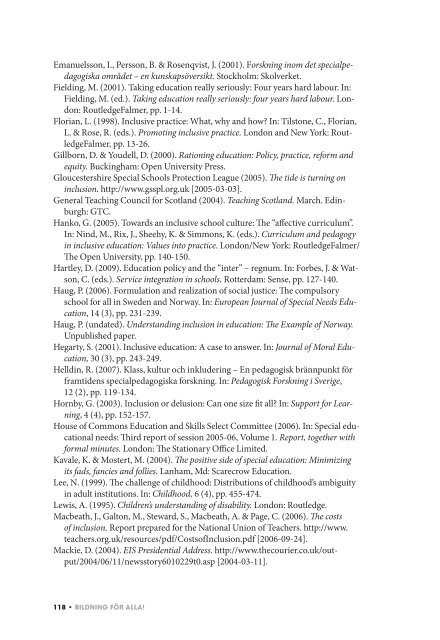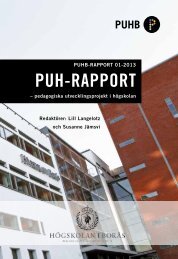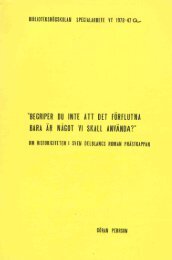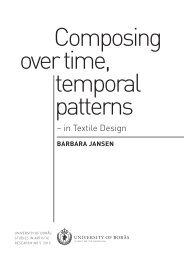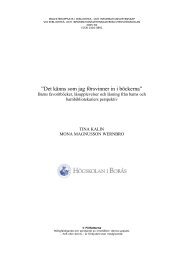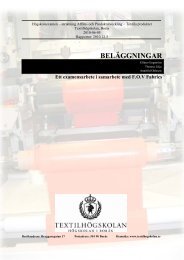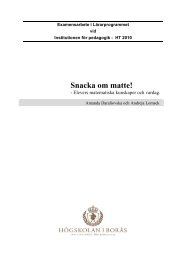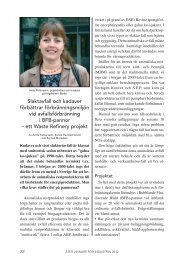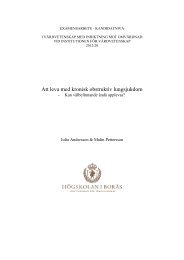Bildning för alla! - DiVA
Bildning för alla! - DiVA
Bildning för alla! - DiVA
You also want an ePaper? Increase the reach of your titles
YUMPU automatically turns print PDFs into web optimized ePapers that Google loves.
Emanuelsson, I., Persson, B. & Rosenqvist, J. (2001). Forskning inom det specialpedagogiska<br />
området – en kunskapsöversikt. Stockholm: Skolverket.<br />
Fielding, M. (2001). Taking education really seriously: Four years hard labour. In:<br />
Fielding, M. (ed.). Taking education really seriously: four years hard labour. London:<br />
RoutledgeFalmer, pp. 1-14.<br />
Florian, L. (1998). Inclusive practice: What, why and how? In: Tilstone, C., Florian,<br />
L. & Rose, R. (eds.). Promoting inclusive practice. London and New York: RoutledgeFalmer,<br />
pp. 13-26.<br />
Gillborn, D. & Youdell, D. (2000). Rationing education: Policy, practice, reform and<br />
equity. Buckingham: Open University Press.<br />
Gloucestershire Special Schools Protection League (2005). The tide is turning on<br />
inclusion. http://www.gsspl.org.uk [2005-03-03].<br />
General Teaching Council for Scotland (2004). Teaching Scotland. March. Edinburgh:<br />
GTC.<br />
Hanko, G. (2005). Towards an inclusive school culture: The “affective curriculum”.<br />
In: Nind, M., Rix, J., Sheehy, K. & Simmons, K. (eds.). Curriculum and pedagogy<br />
in inclusive education: Values into practice. London/New York: RoutledgeFalmer/<br />
The Open University, pp. 140-150.<br />
Hartley, D. (2009). Education policy and the “inter” – regnum. In: Forbes, J. & Watson,<br />
C. (eds.). Service integration in schools. Rotterdam: Sense, pp. 127-140.<br />
Haug, P. (2006). Formulation and realization of social justice: The compulsory<br />
school for all in Sweden and Norway. In: European Journal of Special Needs Education,<br />
14 (3), pp. 231-239.<br />
Haug, P. (undated). Understanding inclusion in education: The Example of Norway.<br />
Unpublished paper.<br />
Hegarty, S. (2001). Inclusive education: A case to answer. In: Journal of Moral Education,<br />
30 (3), pp. 243-249.<br />
Helldin, R. (2007). Klass, kultur och inkludering – En pedagogisk brännpunkt <strong>för</strong><br />
framtidens specialpedagogiska forskning. In: Pedagogisk Forskning i Sverige,<br />
12 (2), pp. 119-134.<br />
Hornby, G. (2003). Inclusion or delusion: Can one size fit all? In: Support for Learning,<br />
4 (4), pp. 152-157.<br />
House of Commons Education and Skills Select Committee (2006). In: Special educational<br />
needs: Third report of session 2005-06, Volume 1. Report, together with<br />
formal minutes. London: The Stationary Office Limited.<br />
Kavale, K. & Mostert, M. (2004). The positive side of special education: Minimizing<br />
its fads, fancies and follies. Lanham, Md: Scarecrow Education.<br />
Lee, N. (1999). The challenge of childhood: Distributions of childhood’s ambiguity<br />
in adult institutions. In: Childhood, 6 (4), pp. 455-474.<br />
Lewis, A. (1995). Children’s understanding of disability. London: Routledge.<br />
Macbeath, J., Galton, M., Steward, S., Macbeath, A. & Page, C. (2006). The costs<br />
of inclusion. Report prepared for the National Union of Teachers. http://www.<br />
teachers.org.uk/resources/pdf/CostsofInclusion.pdf [2006-09-24].<br />
Mackie, D. (2004). EIS Presidential Address. http://www.thecourier.co.uk/output/2004/06/11/newsstory6010229t0.asp<br />
[2004-03-11].<br />
118 • BilDning fÖr AllA!


